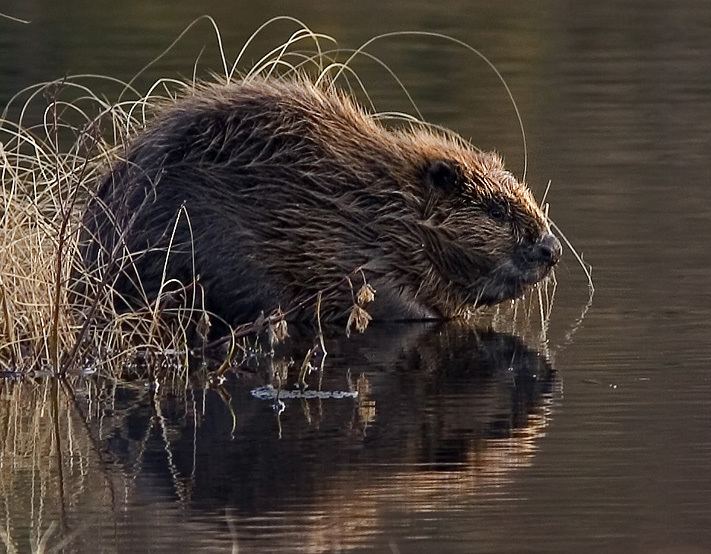This is a list of the mammal species recorded in Croatia. There are 59 mammal species in Croatia, of which 0 are critically endangered, 0 are endangered, 7 are vulnerable, and 4 are near-threatened.
The following tags are used to highlight each species' conservation status as assessed by the IUCN:
Some species were assessed using an earlier set of criteria. Species assessed using this system have the following instead of near threatened and least concern categories:
Rodents make up the largest order of mammals, with over 40 percent of mammalian species. They have two incisors in the upper and lower jaw which grow continually and must be keep short by gnawing. Most rodents are small though the capybara can weigh up to 45 kg (100 lb).
Suborder: Sciurognathi
Family: Castoridae (beavers)
Genus: Castor
European beaver Castor fiber NT
Family: Sciuridae (squirrels)
Subfamily: Sciurinae
Tribe: Sciurini
Genus: Sciurus
Red squirrel Sciurus vulgaris NT
Subfamily: Xerinae
Tribe: Marmotini
Genus: Marmota
Alpine marmot Marmota marmota LR/lc
Family: Gliridae (dormice)
Subfamily: Leithiinae
Genus: Dryomys
Forest dormouse Dryomys nitedula LR/nt
Genus: Eliomys
Garden dormouse Eliomys quercinus VU
Genus: Muscardinus
Hazel dormouse Muscardinus avellanarius LR/nt
Subfamily: Glirinae
Genus: Glis
Edible dormouse Glis glis LR/nt
Family: Cricetidae
Subfamily: Arvicolinae
Genus: Arvicola
Water vole Arvicola terrestris LR/lc
Genus: Chionomys
Snow vole Chionomys nivalis LR/nt
Genus: Clethrionomys
Bank vole Clethrionomys glareolus LR/lc
Genus: Dinaromys
Balkan snow vole Dinaromys bogdanovi LR/nt
Genus: Microtus
Field vole Microtus agrestis LR/lc
Common vole Microtus arvalis LR/lc
European pine vole Microtus subterraneus LR/lc
Family: Muridae (mice, rats, voles, gerbils, hamsters, etc.)
Subfamily: Murinae
Genus: Apodemus
Striped field mouse Apodemus agrarius LR/lc
Yellow-necked mouse Apodemus flavicollis LR/lc
Broad-toothed field mouse Apodemus mystacinus LR/lc
Wood mouse Apodemus sylvaticus LC
Ural field mouse Apodemus uralensis LR/lc
Genus: Micromys
Harvest mouse Micromys minutus LR/nt
Genus: Mus
Steppe mouse Mus spicilegus LR/nt
The lagomorphs comprise two families, Leporidae (hares and rabbits), and Ochotonidae (pikas). Though they can resemble rodents, and were classified as a superfamily in that order until the early 20th century, they have since been considered a separate order. They differ from rodents in a number of physical characteristics, such as having four incisors in the upper jaw rather than two.
Family: Leporidae (rabbits, hares)
Genus: Oryctolagus
European rabbit Oryctolagus cuniculus LR/lc
Genus: Lepus
European hare Lepus europaeus LR/lc
The order Erinaceomorpha contains a single family, Erinaceidae, which comprise the hedgehogs and gymnures. The hedgehogs are easily recognised by their spines while gymnures look more like large rats.
Family: Erinaceidae (hedgehogs)
Subfamily: Erinaceinae
Genus: Erinaceus
West European hedgehog Erinaceus europaeus LR/lc
The "shrew-forms" are insectivorous mammals. The shrews and solenodons closely resemble mice while the moles are stout-bodied burrowers.
Family: Soricidae (shrews)
Subfamily: Crocidurinae
Genus: Crocidura
Bicolored shrew Crocidura leucodon LR/lc
Lesser white-toothed shrew Crocidura suaveolens LR/lc
Subfamily: Soricinae
Tribe: Nectogalini
Genus: Neomys
Southern water shrew Neomys anomalus LR/lc
Eurasian water shrew Neomys fodiens LR/lc
Tribe: Soricini
Genus: Sorex
Alpine shrew Sorex alpinus LR/lc
Common shrew Sorex araneus LR/lc
The bats' most distinguishing feature is that their forelimbs are developed as wings, making them the only mammals in the world naturally capable of flight. Bat species account for about 20% of all mammals.
Family: Vespertilionidae
Subfamily: Myotinae
Genus: Myotis
Bechstein's bat Myotis bechsteini VU
Long-fingered bat Myotis capaccinii VU
Geoffroy's bat Myotis emarginatus VU
Subfamily: Vespertilioninae
Genus: Barbastella
Barbastelle Barbastella barbastellus VU
Genus: Nyctalus
Greater noctule bat Nyctalus lasiopterus LR/nt
Lesser noctule Nyctalus leisleri LR/nt
Subfamily: Miniopterinae
Genus: Miniopterus
Schreibers' long-fingered bat Miniopterus schreibersii LC
Family: Rhinolophidae
Subfamily: Rhinolophinae
Genus: Rhinolophus
Mediterranean horseshoe bat Rhinolophus euryale VU
Greater horseshoe bat Rhinolophus ferrumequinum LR/nt
Lesser horseshoe bat Rhinolophus hipposideros LC
Mehely's horseshoe bat Rhinolophus mehelyi VU
The order Cetacea includes whales, dolphins and porpoises. They are the mammals most fully adapted to aquatic life with a spindle-shaped nearly hairless body, protected by a thick layer of blubber, and forelimbs and tail modified to provide propulsion underwater.
Suborder: Mysticeti
Family: Balaenopteridae
Genus: Balaenoptera (rorquals)
Fin whale Balaenoptera physalus EN
Common minke whale Balaenoptera acutorostrata NT
Subfamily: Megapterinae
Genus: Megaptera
Humpback whale Megaptera novaeangliae LC
Suborder: Odontoceti
Family: Physeteridae (sperm whales)
Genus: Physeter
Sperm whale Physeter macrocephalus VU
Superfamily: Platanistoidea
Family: Delphinidae (marine dolphins)
Genus: Tursiops
Common bottlenose dolphin Tursiops truncatus DD
Genus: Stenella
Striped dolphin Stenella coeruleoalba LR/cd
Genus: Delphinus
Common dolphin Delphinus delphis LR/lc
Genus: Grampus
Risso's dolphin Grampus griseus DD
There are over 260 species of carnivorans, the majority of which eat meat as their primary dietary item. They have a characteristic skull shape and dentition.
Suborder: Feliformia
Family: Felidae (cats)
Subfamily: Felinae
Genus: Felis
Wildcat Felis silvestris LC
Genus: Lynx
Eurasian lynx Lynx lynx NT
Suborder: Caniformia
Family: Canidae (dogs, foxes)
Genus: Vulpes
Red fox Vulpes vulpes LC
Genus: Canis
Golden jackal Canis aureus LC
Gray wolf Canis lupus LC
Family: Ursidae (bears)
Genus: Ursus
Brown bear Ursus arctos LR/lc
Family: Mustelidae (mustelids)
Genus: Mustela
Stoat Mustela erminea LR/lc
Least weasel Mustela nivalis LR/lc
European polecat Mustela putorius LR/lc
Genus: Martes
Beech marten Martes foina LR/lc
Genus: Meles
Eurasian badger Meles meles LR/lc
Genus: Lutra
European otter Lutra lutra NT
The even-toed ungulates are ungulates whose weight is borne about equally by the third and fourth toes, rather than mostly or entirely by the third as in perissodactyls. There are about 220 artiodactyl species, including many that are of great economic importance to humans.
Family: Suidae (pigs)
Subfamily: Suinae
Genus: Sus
Boar Sus scrofa LR/lc
Family: Cervidae (deer)
Subfamily: Cervinae
Genus: Cervus
Red deer Cervus elaphus LR/lc
Subfamily: Capreolinae
Genus: Alces
Moose Alces alces LR/lc
Genus: Capreolus
Roe deer Capreolus capreolus LR/lc

